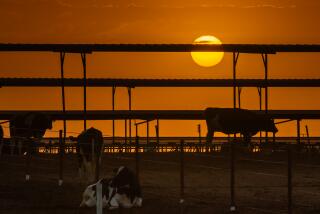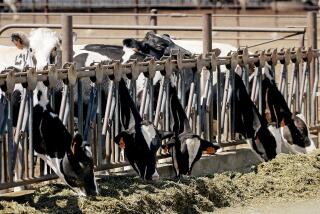Mad Cow Could Keep Cattle Prices Lower for Months
- Share via
HONOLULU — Ranchers will suffer lower cattle prices “for some time to come” because of the first U.S. case of mad cow disease, despite Americans’ unwavering appetite for hamburgers, steaks, ribs and roasts, the head of the largest U.S. farm group said Sunday.
The U.S. response to mad cow disease was expected to dominate the annual meeting of the 5.5-million-member American Farm Bureau Federation here.
Cattle prices have fallen about 15% since the Dec. 23 discovery of the disease in a Holstein dairy cow in Washington state.
In a speech opening the convention, federation President Bob Stallman said, “The good news is that the latest polls are showing American consumers are continuing to purchase, consume and enjoy American beef.”
The slaughtered Holstein that tested positive for bovine spongiform encephalopathy -- the formal name for mad cow disease -- was from a ranch near Mabton, Wash., where locals gathered Saturday to eat beef at a rally in support of the cattle industry.
Despite frigid winter weather, the rally attracted about 2,000 people from in and around Mabton, a farming town of 1,900. Volunteers charbroiled hamburger patties, hot dogs and beef ribs that were given away.
“The beef industry, the cattle industry is so important to the Yakima Valley and we just don’t want to see anything bad happen,” said Cheryl Salomone, vice president of the local radio station that organized the rally.
Since the Holstein tested positive, dozens of nations have cut off U.S. beef imports. The Bush administration has unveiled several new safeguards, including a ban on using sick or crippled “downer” cattle for human food.
The administration also said it would accelerate development of a uniform animal identification system, which would simplify the response to outbreaks of dangerous diseases.
To be successful, animal identification must be mandatory, Brad Wildeman, chairman of the Canadian Cattle Identification Agency, said at the convention. Canada reached a compliance rate well above 99% after making registration mandatory in July 2002, he said. When it was voluntary, only 75% of cattle were registered.
U.S. farmers traditionally are wary of government intrusion on the farm. But livestock producers were expected to be more receptive to animal ID in the wake of the mad cow case.
When convention delegates begin policy debate Tuesday, they will be asked to give high priority to development of a U.S. animal ID system. Numbering systems now vary from farm to farm.
Wildeman said the Canadian system, which is run by the cattle industry, was invaluable in tracking down herd mates of infected cows. Canada reported its first native case of mad cow disease May 20 and was the birthplace of the cow in the U.S. case.
“It’s a good thing that dairy cow [in Washington state] was born in Canada. We’d never have found her,” an Oregon farmer told Wildeman.
A consortium of federal, state and industry officials were drafting a U.S. animal ID plan that would take its first step this summer: the issuance of identification numbers for farms, ranches and feedlots.
Assignment of animal ID numbers would begin in early 2005.
With cattle ID, Wildeman said, “we saved the slaughter, we think, of 10,000 cattle” by accurately tracing animals in the mad cow investigations.
By comparison, U.S. officials ordered the slaughter of a herd of 450 bull calves because they could not be sure which one was the offspring of the infected cow in Washington state.
More to Read
Sign up for Essential California
The most important California stories and recommendations in your inbox every morning.
You may occasionally receive promotional content from the Los Angeles Times.










